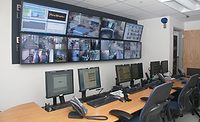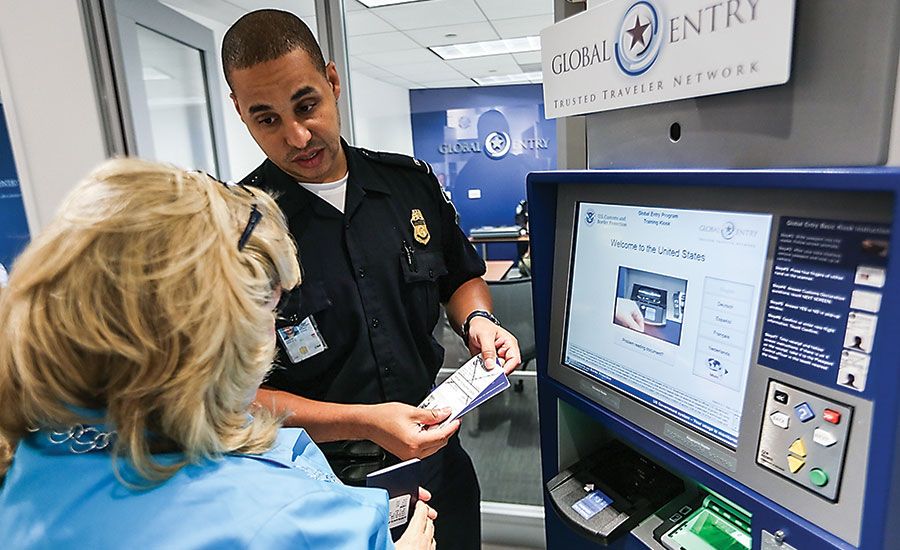Finding Force Multipliers for Port Security


Automated, linear gates are used to protect vulnerable piers at Naval Station Pearl Harbor in Hawaii. Photo courtesy of Delta Scientific

“With the first online aviation security degree, Embry-Riddle Worldwide will be the global leader in aviation security education,” says Dr. Daniel J. Benny, program chair. Photo courtesy of Embry-Riddle Worldwide

Security video at Los Angeles Airport is an essential part of the overall operation. Photo courtesy of Nice Systems

Thanks to partitioning, both TSA and contractors like the parking management company can remotely access security cameras in the parking garages and at screening checkpoints. Photo courtesy of Genetec





Ports – sea, air and land – handle people and cargo. And they need to be secured. Dr. Daniel J. Benny knows the need. At Embry-Riddle Aeronautical University, Dr. Benny now offers a Bachelor of Science degree in aviation security. This program is designed to produce graduates qualified to enter aviation security, intelligence, military, homeland defense and corporate aviation security communities, either as entry-level career professionals or as mid-level managers.
For many aviation security and intelligence professionals currently working in these communities, the degree will be seen as a qualification for promotion in the middle and even upper levels of management or military command. It’s also designed to provide students with the skills and knowledge for specialized positions in aviation security.
“With the first online aviation security degree, Embry-Riddle Worldwide will be the global leader in aviation security education,” says Dr. Benny, program chair. “It’s broad coverage from commercial service airports through general aviation airports as well as maintenance areas. And all types of aircraft including unmanned.”
Fencing a First Barrier
Concerning physical security of airports, Dr. Benny sees fencing at the heart. “Intrusion detection is important. So is laser use on the perimeter and the lighting must be placed correctly. There needs to be a perimeter road for airport security to patrol and signage as well as card access at fence line utility gates.” There also are cameras, including IP and low light, which are monitored.
Hardened security is often the case at seaports.
For example, anti-terrorist barriers protect the international cruise ship terminal at the Port of Sydney Harbour in Australia. The Delta Scientific barriers lie flat in the road until activated, at which point they spring up at a 45-degree angle and effectively stop a speeding vehicle in its tracks. The barricade stops and destroys a 15,000 pound vehicle traveling 50 mph. Set in a foundation only 18 inches deep, the device is able to survive and operate after a 1.2 million foot-pound impact. Upon extracting the vehicle after a crash test, the barricade was fully functional and performed 27,000 additional cycles.
At the Port of Sydney Harbour, the barriers prevent speeding vehicles from getting past the guard post at the overseas passenger terminal at Circular Quay, where about 90 vessels dock during the busy summer months. Nearly 160,000 passengers are expected to come through the port, representing a major facet of Australia’s tourism industry.
The anti-terrorist barriers were installed as part of an effort to upgrade security at ports in the state of New South Wales. Other heightened security measures include security video, exclusion zones and security patrols.
Automated, linear gates are used to protect vulnerable piers at Naval Station Pearl Harbor in Hawaii. The automated gates at the Navy piers create a protective barrier between terrorists and in-port assets. The Navy installed this barrier system in order to provide an adequate level of force protection while maintaining a high level of efficiency on the piers. Before the gates were installed, as one approached the pier they came upon a swing gate guarded by a sentry. It was the sentry’s responsibility exclusively to assess and then grant or deny access.
Sentry Handles Credentials
Now, the piers have a gate or kiosk system that protects the sentry, who remains in the gatehouse and cannot be touched. Anyone attempting to gain access has to slide credentials through a pass window to the sentry. However, even if someone could take out a sentry in the gatehouse, they still cannot get through the gates. These new gates are force multipliers for the security department when operating them in an automated mode during slow periods. An automated gate reduces overall manpower requirements and frees up a security personnel to perform other missions vital to force protection such as patrol, counter surveillance and random inspections.
Pearl Harbor also uses portable barricades that are towed in place and set up in 15 minutes. The fixed barriers and portable barriers are integrated with a series of other force protection equipment and measures to achieve an antiterrorism system based on a defense-in-depth methodology.
Far from Pearl Harbor, Orlando Sanford International Airport (SFB), known as Central Florida’s Gateway to the Sun, is one of the busiest airports in the United States. Established in 1968, the Orlando facility handles two million passengers each year.
In an airport of such capacity, response time to incidents is crucial for effective decision making and thus, for ensuring the safety of personnel and visitors of the airport. Although SFB did employ an older commercial-grade analog system to monitor security issues, this system did not have the functionality nor the capacity to properly archive video recordings, since it utilized VCR technology. Similarly, there was no way of verifying that live camera video feeds were actually being recorded as anticipated, and maneuvering amongst and extracting archived video was not deemed an easy or quick process.
With years of experience in airport security and loads of knowledge on the existing system, Bryant Garrett, CFO and chief of the Sanford Airport Police Department, was responsible for overseeing the selection of the new system. According to Garrett, “a non-proprietary system would allow Sanford to get competitive bids from multiple hardware vendors.” Additionally, he wanted to be able to have a multiple camera screen presentation and the functionality to manipulate pan/tilt/zoom cameras. Most importantly, he wanted to be able to quickly switch from live to archived videos and easily export selections of archived videos in high-quality format for other authorities to review from another monitoring station.
Depending on IP Video
In Texas, Port Freeport, one of the fastest growing ports on the Gulf Coast, has invested in the latest IP video surveillance technology to monitor incoming cargo ships and secure the water-side perimeter.
With massive cargo ships coming into the port daily from Brazil, China, Colombia, Costa Rica, Mexico, Venezuela and many more, and employing more than 13,000 people, Port Freeport uses video surveillance technology to ensure the safety of its employees as well as to ensure the smooth execution of daily operations. More so, as one of the fastest growing ports on the Gulf Coast, Port Freeport is in constant surveillance of incoming threats from the water perimeter.
Port Freeport had previously installed an analog-based video surveillance system, but as years passed and the port expanded, their requirements for newer technology such as vessel tracking through a radar system became a necessity. Unfortunately, the outdated functionalities of their existing system denied them the ability to fully integrate this newer technology, as well as forbid them from further custom development with other solutions that they were prospecting.
The port was also looking to incorporate some additional wireless cameras into their system and had concerns about the video quality that would be produced from their dated video surveillance system. Ultimately, they knew they needed to start looking at the latest advancements in IP video surveillance technology, so they entrusted LANAIR Group, a system integration company based in Los Angeles to propose a solution that would fulfill their integration requirements.
It was Rick Benavidez, director of safety and security at Port Freeport, who was in charge of selecting a product that would help fulfill their security needs today, and well within the future. “Really, the requirements were simple. We were looking for a more advanced IP-based system that would allow the integration with our vessel-radar system, and also offer us the possibility to grow the system as we move forward. We left it up to LANAIR Group to make the recommendation,” says Benavidez. In typical port applications, it is common to find that the radar system acts independently from the video surveillance system, having operators respond to incoming vessels by manually prompting the water-side cameras that are deemed closest to validate the vessel in question. Port Freeport on the other hand had bigger plans. Ideally, Port Freeport wanted a new system that would allow them to automate the camera prompt when a vessel was detected in their security zone via the radar system. Their main objective was to leverage both technologies’ strengths as well as to facilitate and streamline the decision-making process for all operators at the port.
Open Architecture Design
In order to accomplish this objective, Port Freeport needed an open architecture system that would offer highly developed integration capabilities, possibly through an advanced software development kit. They were also looking for a technologically mature video surveillance solution that would enable them to incorporate more wireless camera technology and expand their camera count in the future with ease. Finally, seeing as the Port was growing rapidly in size, they had to ensure that the new video surveillance solution would be one that was scalable and could accommodate their growing needs.
Steve Rogers of LANAIR proposed Genetec’s IP video surveillance solution, Omnicast.
To add to Port Freeport’s enhanced security, some new wirelessly-connected cameras were installed on radar towers a couple miles out from the port. With a system comprising of a little more than 40 Pelco cameras placed throughout the landside and waterside of the port, this reason amongst others gave Port Freeport exactly what they had been searching for in their new video surveillance solution. First and foremost, the custom code for the integration was written by LANAIR and in less than a month, Omnicast and the radar system were fully integrated.
On the radar system, there is a line of demarcation and when a vessel is detected as heading towards the line, it turns yellow. If the vessel continues in the same direction, the line turns red, and the radar system sends an alarm to the operators while prompting the cameras closest to the ship. The radar system will even continue to toggle video feeds from cameras alongside the vessel as it moves closer to the port.
New wirelessly-connected cameras were installed on radar towers a couple miles out from the port, where incoming vessels into the Federal Channel could be tracked. With no direct connectivity due to distance and topography, the security cameras were installed with point-to-point wireless encoders and receivers, which facilitated communication.
Similar technology protects Tampa International Airport (TPA), says Safraz Samad, security project manager at TPA.
More Incident Information
Today, the video surveillance system manages more than 800 cameras, and TPA has been pleased with the results. According to Samad, “Our police use it extensively and have archived over 100 cases in the last seven months. They are able to find video, open cases with more information and then close these cases faster. At the checkpoints, we have daily recoveries of lost or forgotten items which are resolved within minutes.”
“It has made our jobs a lot easier in terms of managing alarms and for general usability,” explains Samad. “We have much more camera coverage and the cameras are linked to the access control system triggers, so we get recorded video instantaneously alongside alarms. The video replay is programmed however we want it, either 15 seconds or 30 seconds behind, and so we are able to mitigate these alarms and show that we didn’t have a security breach, and if we do, get the appropriate people out there.”
Thanks to partitioning, both TSA and contractors like the parking management company can remotely access the cameras in the parking garages and at the screening checkpoints. Operational teams at TPA also use the cameras to help streamline the flow of traffic in and out of the airport, and anticipate crowds in security, customs or baggage claim.
The video surveillance system manages more than 800 cameras from Arecont Vision, Axis Communications, Pelco and more. The Arecont Vision cameras include 180 and 360-degree multi-imager devices, which provide four video feeds under a single camera license. More than one petabyte of storage is available for video recordings on more than 60 Pivot3 servers distributed in six locations throughout the airport.
At Los Angeles International Airport (LAX), the sixth busiest airport in the world serves nearly 71 million passengers annually. LAX’s operation is dynamic, consisting of many moving parts from parking structures to restrooms to runways. LAX’s Airport Response Coordination Center (ARCC) and airport operations staff are responsible for ensuring the smooth flow of passengers, bags and aircraft, maintaining situational awareness and a common operating picture for minor and major incidents.
Airport Nerve Center
LAX’s ARCC, made up of airport operations, airport police, facilities maintenance, TSA and information technology staff, is the nerve center of the airport, monitoring airfield, landside, and terminal operations. ARCC staff work with their counterparts in the field to obtain updates on various facility assets and airport incidents, and use that information to develop collaborative response plans.
Operations field staff utilize Nice Situator’s Geographic Information System (GIS) Web viewer via iPads to notify the ARCC when an incident occurs, access standard operating procedures for handling that incident, identify on the map where the incident is taking place, and provide updates. These updates are made available immediately to ARCC staff.
GIS and mobility provides information about LAX’s physical infrastructure data and puts it in the hands of the staff in the field and the ARCC enabling them to have improved situational awareness.
The effectiveness of the technology at LAX to manage major incidents was demonstrated during a recent SkyWest flight that made an emergency landing at LAX. The SkyWest flight landed on Runway 24L without its left landing gear. When the plane came to a stop, LAX Police, fire, operations and maintenance staff were on site. Passengers exited the aircraft without incident and were bused to the terminal.
Situational Awareness
At this point, the ARCC and operations tasks to manage the situation were just getting started. The security technology and GIS were used to manage this incident from start to finish, including identifying where on the runway the incident took place, runway and taxiway closures, location of the command post and incident perimeter, documenting each activity and providing comments about the situation as it progressed through the day. This information enabled the ARCC staff and incident manager to have a strong common operating picture and provided a summary of the event.
In another application, ProRail, the rail infrastructure management company of the Netherlands, has succeeded in reducing incident response time by more than 60 percent since implementing Nice Situator. This has enabled ProRail to react faster and more efficiently to unfolding events, thereby minimizing or preventing disruptions while safeguarding passengers, staff and infrastructure.
The project was implemented in partnership with Geodan, an expert in location intelligence and operational incident management solutions. Using the solution, ProRail manages tens of thousands of incidents a year out of the centralized Operational Control Center Rail in Utrecht, including technical failures, incidents and crisis situations.
The solution also facilitates intelligent, mass notification which allows for the prompt and accurate alerting of key stakeholders, and provides a single platform for sharing and exchanging relevant information about each incident in order to ensure a coordinated response effort.
SIDEBAR: Convenience and Security Combined
Travelers using Global Entry bypass filling out the immigration cards distributed by the flight crew before landing. After you answer immigration-related questions at the kiosk, a receipt is printed out for customs inspectors. The entire procedure takes less than a minute.
The application process is similar to that of TSA Precheck: a background check involving an online application and a brief interview at one of 35 U.S. airports.
SIDEBAR: Atlantic City Airport with New Fencing
More than a mile of new fencing on the grounds of Atlantic City International Airport prevents vehicles from driving onto the runways, taxiways or other sensitive areas. The nearly $875,000 project includes 7,200 feet of inner fencing to create an extra layer of security.
“The fence is being installed to help prevent possible vehicle incursions on the airfield due to vehicular traffic within the airport operations area,” Tim Kroll, deputy airport director for the South Jersey Transportation Authority, the airport’s owner and operator, told local media.
Looking for a reprint of this article?
From high-res PDFs to custom plaques, order your copy today!











